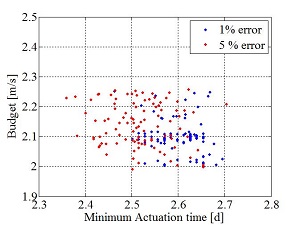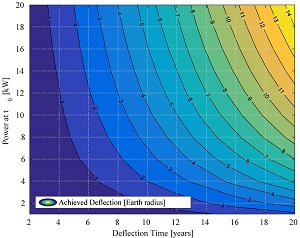Research Topic:
Advanced methods to orbit about asteroids and mitigate the risk of impact with Earth
The main research activity is related to the development of a high-fidelity propagation of spacecraft trajectories about irregular asteroids. In particular the aim is to fully describe close-proximity operations considering the whole guidance navigation and control (GNC) process for inertial and body-fixed hovering missions. One important aspect is to evaluate how the different control techniques and on-board instruments affect the performance of the system. In this respect also the stability of the selected nominal trajectory plays a significant role, since unstable hovering position will be more demanding for the control system. Among the possible missions that require the spacecraft to fly close to the asteroid there are asteroid deflection missions. The interest is in the low push methods, i.e. laser ablation, ion-beam shepherd and gravity tractor, where the spacecraft is required to maintain suitable illumination condition while keeping a fixed relative configuration with respect to the asteroid. Detailed models about the close proximity environment and the involved operations will also help in preliminary assessment of mission requirements especially under the presence of uncertainties.
Main Results:
A first version of the High-fidelity Asteroid Deflection Software (HADES) which includes the main GNC functionalities have been developed and tested. Different control techniques based on both continuous and discrete methods have been considered and compared. A preliminary control budget for the station keeping of the Asteroid Impact Mission (AIM) at 10 km for different accuracy levels proved to be consistent with expected results of about 2 m/s. The study of the stability of the orbits have mainly focused on the development of a suitable technique based on the fast Lyapunov exponents, considering a complementary problem represented by the production of debris on the surface of a rotating asteroid. We found trajectories are in general unstable that due to the overall effect of the perturbations but there are cases which show higher residence time before leaving or impacting the asteroid. An initial activity on the asteroid deflection has seen the use of refined laser ablation model and asteroid shape models. Different control techniques were considered by: 1) optimizing the laser pointing to obtain the thrust directed as the desired one, 2) maintaining a fixed pointing and letting the surface move beneath. The first choice proves to be more efficient although the second one is the simpler from the operational point of view not requiring mechanism to adjust the pointing and real time tracking of the visible surface.


Figure 1. Simulated camera model with different centroiding identification techniques (left). Footprint of the LIDAR (right)


Figure 2. Relative estimation error example: position (left), velocity (right) using navigation camera and LIDAR instruments.


Figure 3. Navigation budget for inertial hovering at 10 km from the asteroid Dydimos (left), typical illumination angle trend (right).


Figure 4. Example of debris analysis: survival rate (left), cumulative function of survival particle spatial distribution after one orbital period (right) for different asteroid rotational velocity.


Figure 4. Asteroid deflection: thrust direction control (left), laser fixed-pointing (right).


Figure 4. Asteroid deflection for different mission duration and power available: thrust direction control (left), laser fixed-pointing (right).
References:
M. Vetrisano and M. Vasile. Autonomous navigation of a spacecraft formation in the proximity of an asteroid. Advances in Space Research. Volume 56, Issue 8, Pages 1547-1804 (15 October 2015). doi:10.1016/j.asr.2015.07.024.
M. Vetrisano, C. Colombo and M. Vasile. Asteroid rotation and orbit control via laser ablation. Advances in Space Research. Volume 56, Issue 8, Pages 1547-1804 (15 October 2015). doi:10.1016/j.asr.2015.06.035
M. Vetrisano, N. Thiry, C. Tardioli. Asteroid’s Orbit and Rotational Control Using Laser Ablation: Advances in Physical and Simulation Modelling – poster presented at the Planetary Defence Conference, Frascati, 13-17 April, 2015.
M. Vetrisano, N. Thiry, C. Tardioli. Asteroid’s Orbit and Rotational Control Using Laser Ablation: Towards High Fidelity Modelling of a Deflection Mission – paper presented at the International Symposium on Flight Dynamics, Munich, Germany, October 19-23, 2015.
2-
Resources:
ResearchGate: http://www.researchgate.net/profile/Massimo_Vetrisano
Linkedin:
https://it.linkedin.com/in/massimovetrisano